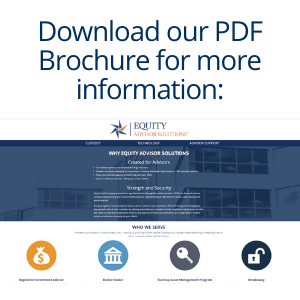If you’re one of the 73% of advisors with no succession plan, this post is for you—especially if your firm is small.
Imagine that one day, you stop showing up at the office and never return. Perhaps there’s an accident, a medical emergency, or something else unexpected.
Whose job is it to keep your business going? Who will…
- Reassure your clients? Your clients placed their faith in you personally, not in a huge national brand. Every small firm needs a back-up person with the credibility to proclaim, “I’m your advisor now.” Do your clients already know that individual, or would they receive a call from a stranger? How many clients would walk?
- Retain employees? Your team joined your firm because they believed in you. Who else do they trust to lead the business? Like everyone else, your employees have bills to pay. If their futures feel uncertain, they will leave.
- Run your business? If you manage most of your vendor relationships, who else knows what needs to be done and when? Many small firms literally cannot keep the lights on without the founder stepping in.
- Pay your family’s bills? FINRA Rule 2040 excludes your spouse and heirs from collecting client commissions or advisory fees unless they’re licensed themselves. As a small, independent advisor, you could lose everything in an instant unless someone is already lined up to buy your firm.
- Get the best price from the right buyer? A business without a succession plan will fetch a far lower price than one that’s been well prepared to retain and grow value. Too often, families are forced to sell at fire-sale prices to less-than-ideal buyers.
Simple succession planning with 3 quick hacks.
The stakes of operating without a succession plan are high—especially for a small firm suddenly deprived of its founder. So why do advisors put off making one?
In general, people procrastinate not because they’re lazy, but because it can be a stressful process. They fear making a big mistake or losing their sense of control.
Here are three hacks you can try to finish your succession plan without feeling overwhelmed. We’ve broken down big tasks into small, manageable chunks. You can tackle one at a time, whenever you have a spare moment. Over time, you’ll lay the groundwork for a complete succession plan—and reduce risk to your firm.
5-Minute Hack #1: Define your personal goals.
Before you can plan, you must know what you’re planning for. What kind of life do you want to live after you retire? What do you want for your business?
Define the goals of your succession plan as specifically as possible, including:
- Target retirement year. When will you be ready to retire or sell the business?
- Proceeds required. What assets or income do you need to fund your desired lifestyle? Remember that your ideal price may not match a market-based valuation.
- Risk tolerance. A transaction may generate cash, equity, or future income depending on the structure of a deal. What forms of compensation are you comfortable accepting?
- Goals for employees. Do you want to ensure employees can keep their jobs? How much of your own compensation are you willing to trade off in return? Retaining employees helps preserve the value of a firm as a going concern, but you must also consider your own needs.
- Goals for clients. Are you looking to ensure a specific standard of service for your clients?
- Willingness to let go. Are you ready to wash your hands of your business, or do you prefer to stay involved? Be honest with yourself. Leaving a business you built is never easy, but;
In just five minutes, you’ll have taken a critical first step toward creating a succession plan.
5-Minute Hack #2: Identify critical roles.
Do you have the right team in place to complete a successful business transition? If not, what roles do you need to fill?
Create a checklist to identify:
- Short-term business continuity roles, including operations professionals and decision-makers to handle vendor, banking, custody and other business relationships
- Long-term successors, such as partners or senior professionals you could groom to replace you
- Potential purchasers, including other advisor firms, family members, network members or institutions
- Third-party professional services that focus on succession planning, such as valuation experts or attorneys
Identify gaps and map out your next steps to fill them. For each gap, you can create another 5-minute hack to identify and contact candidates.
5-Minute Hack #3: Make one phone call.
Schedule one phone call to move your succession plan forward. Whom should you call? You can refer to the list of roles you created in the prior hack. It’s often easiest to start with a third-party vendor, such as a:
- Valuation specialist
- Business transition specialist
- CPA who specializes in business transitions
- Specialized insurance agency that offers key person insurance
At this stage, your goals are to assess potential fit and plan next steps, if appropriate.
If you’re ready to initiate a conversation with a potential buyer or successor, check out our next post with special interviewing tips.
Custody and Administration Services provided by Equity Trust Company. Equity Advisor Solutions is an affiliate of Equity Trust Company.


